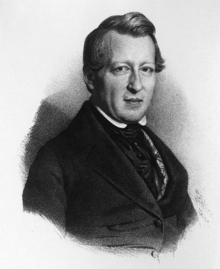Otto Linné Erdmann
| Otto Linné Erdmann | |
|---|---|
 Otto Linné Erdmann | |
| Born |
11 April 1804 Dresden, Germany |
| Died |
9 October 1869 (aged 65) Leipzig, Germany |
| Nationality | German |
Otto Linné Erdmann (11 April 1804 – 9 October 1869) was a German chemist. He was the son of Karl Gottfried Erdmann, the physician who introduced vaccination into Saxony. He was born in Dresden on 11 April 1804. In 1820 he began to attend the medicochirurgical academy of his native place, and in 1822 he entered the University of Leipzig, where in 1827 he became extraordinary professor, and in 1830 ordinary professor of chemistry. This office he held until his death, which happened at Leipzig on 9 October 1869. He was particularly successful as a teacher, and the laboratory established at Leipzig under his direction in 1843 was long regarded as a model institution. As an investigator he is best known for his work on nickel and indigo and other dye-stuffs. With R. F. Marchand (1813–1850) he also carried out a number of determinations of atomic weights. In 1828, in conjunction with A. F. G. Werther (1815–1869), he founded the Journal für technische and ökonomische Chemie, which became in 1834 the Journal für praktische Chemie. He was also the author of Über das Nickel (1827), Lehrbuch der Chemie (1828), Grundriss der Waarenkunde (1833), and Über das Studium der Chemie (1861).[1]
Notes
- ↑
 This article incorporates text from a publication now in the public domain: Chisholm, Hugh, ed. (1911). "Erdmann, Otto Linné". Encyclopædia Britannica (11th ed.). Cambridge University Press.
This article incorporates text from a publication now in the public domain: Chisholm, Hugh, ed. (1911). "Erdmann, Otto Linné". Encyclopædia Britannica (11th ed.). Cambridge University Press.
References
- "Otto Linné Erdmann: Zum 200. Geburtstag am 11. April 2004" (– SCHOLAR SEARCH). University of Leipzig.
- Hermann Kolbe (1870). "Nekrolog: Otto Linné Erdmann". Berichte der deutschen chemischen Gesellschaft 3 (1): 374–381. doi:10.1002/cber.187000301225.
- Ronge, Grete (1959), "Otto Linné Erdmann", Neue Deutsche Biographie (NDB) (in German) 4, Berlin: Duncker & Humblot, pp. 572–573
|